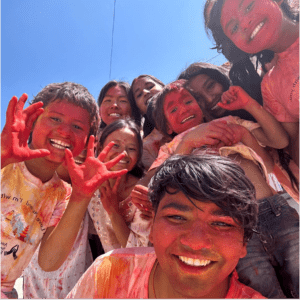Students from Harbingers’ Nepali Newsroom shared their celebration of Holi Festival

March 25, 2024. Paint-covered children at the Mountain Children Home in Dadagaun, Nepal, during the celebration of the Holi festival.
April 18, 2024
A guide to Holi – The Hindu festival of colour
Holi, the Hindu Festival of Colour, is a major event in South Asian countries including India and Nepal. People who observe Holi use this period of time to emphasise positivity and let go of all the negativity in their lives.
It is celebrated during the month of March. People come out onto the streets and throw coloured water and powder at each other, and have a joyful time. Kathmandu, Nepal’s capital, is full of noisy laughing crowds, their clothes and faces covered in different colours.
It is also a time to renew friendships and mend old arguments.
When does it take place?
Holi is celebrated during the months of Chaitra and Falgun in the Nepali calendar, which is usually equivalent to March in the Western calendar. It falls between the end of winter and the start of spring, so it is also a way to celebrate the arrival of spring.
The festivities are split across the different regions of Nepal. This year, the Mountain and Hilly regions celebrated Holi on March 24, followed by the lowland Terai region on March 25.
How and why people celebrate
One way people celebrate Holi is by lighting bonfires on the evening before the festival, to celebrate the victory of good over evil.
Hindu mythology talks about a demonic king named Hiranyakashipu, who wanted everyone to worship only him. However, his son Prahlada disobeyed his orders and stayed loyal to Lord Vishnu. To punish him, Hiranyakashipu ordered his sister Holika (who was immune to fire) to take his son and sit with him on a burning pyre. But the child was saved by his devotion to Lord Vishnu and instead Holika was burned alive.
Some celebrants also refer to Lord Krishna, his love Radha and his cosmic play with the consorts and gopikas (devotees). But the main way they celebrate Holi is by throwing coloured water and coloured powder (known as abeer or abir) at each other. They also dance, sing and eat special foods.




